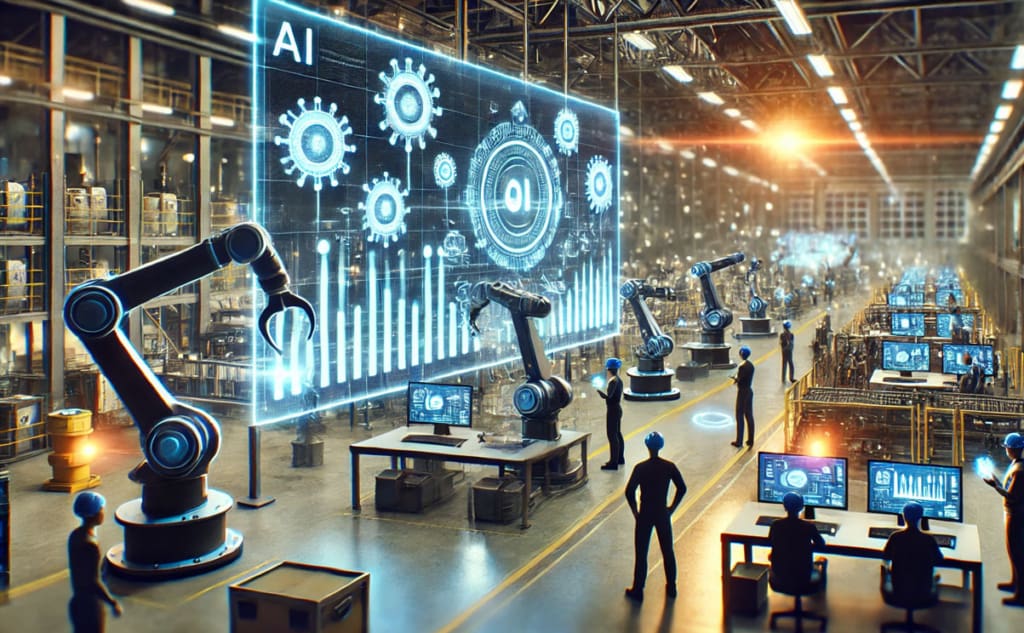AI Agents vs Humans in manufacturing, the race has started.
The manufacturing industry is at a pivotal moment, with artificial intelligence (AI) agents poised to revolutionise the way factories operate. As these intelligent systems take on increasingly sophisticated roles, they are reshaping the workforce, enhancing productivity, and opening up new possibilities for operational efficiency. However, this transformation also raises questions about workforce adaptation, training, and the balance between human and machine collaboration.
No time to read this article, why not listen to the audio conversation.
What Are AI Agents?
AI agents are software systems or robotic entities equipped with artificial intelligence, enabling them to perform tasks autonomously. These tasks range from simple automation processes to complex decision-making functions, such as quality assurance, inventory management, and predictive maintenance. Unlike traditional automation systems, AI agents can learn from data, adapt to new conditions, and improve their performance over time.
In the context of manufacturing, AI agents are being deployed to:
- Monitor production lines to detect anomalies in real time. AI-driven systems use advanced sensor technology and computer vision to constantly analyse production line activity. These systems can identify irregularities such as defective products, misaligned components, or equipment malfunctions as they happen. This enables rapid response, reducing downtime and ensuring consistent product quality.
- Predict equipment failures using predictive analytics. By analysing vast amounts of sensor data from machinery, AI agents can identify patterns that signal potential issues. For instance, an unusual vibration or temperature change might indicate an impending breakdown. Predictive maintenance reduces unplanned downtime, extends the lifespan of equipment, and optimises maintenance schedules.
- Optimise supply chains by analysing market and production data. AI agents can process data from multiple sources, including market trends, supplier performance, and production schedules, to forecast demand and adjust supply chain operations accordingly. This ensures inventory levels are optimised, reducing both overstock and shortages while improving overall operational efficiency.
- Assist in design and prototyping through generative AI models. Generative AI can analyse design parameters and generate innovative prototypes based on functional requirements and constraints. For example, in automotive manufacturing, AI agents can suggest optimised designs for components that are lighter, stronger, and more cost-effective, significantly speeding up the product development cycle.
- Optimise marketing and digital strategies to boost lead generation and sales. AI agents analyse customer behavior, market trends, and engagement data to develop streamlined marketing communications. By automating campaign management, personalising customer outreach, and identifying high-impact opportunities, AI agents enable manufacturers to attract more leads and drive meaningful sales conversations with greater efficiency.
- Enable immersive website conversations with customers to revolutionise how businesses engage online. AI agents can facilitate dynamic interactions by allowing customers and consumers to search product databases, component parts, and technical information with real-time data feeds. This creates a seamless, informative experience for users, positioning manufacturers with AI-enhanced websites as leaders in their field. Such advancements not only enhance customer satisfaction but also set forward-thinking manufacturers apart from those resisting technological innovation.
These capabilities significantly enhance productivity, reduce downtime, improve product quality, streamline marketing strategies, and create immersive customer experiences that set forward-thinking manufacturers apart.

The Benefits of AI Agents for the Workforce
1. Reducing Human Error
AI agents excel at tasks that require precision and consistency, such as quality inspections. By identifying defects or anomalies that might escape human attention, they ensure higher product standards while reducing waste. For instance, advanced visual recognition systems can analyse products on assembly lines, highlighting even the smallest imperfections that human eyes might miss. This level of precision minimises costly recalls and enhances brand reputation.
2. Augmenting Human Roles
Rather than replacing human workers, AI agents are augmenting their roles. For example, they assist machine operators by providing real-time insights into machine performance or suggesting optimal operating conditions. Workers can rely on AI-generated recommendations to adjust processes dynamically, improving output quality and efficiency. This collaboration between humans and AI reduces cognitive workload and allows workers to focus on more strategic and creative aspects of their roles.
3. Improving Workplace Safety
AI agents contribute to safer working environments by taking on dangerous or physically demanding tasks. Robots equipped with AI can handle hasardous materials, work in extreme temperatures, or perform repetitive tasks that might lead to injuries. For example, autonomous drones can inspect high-risk areas such as tall structures or confined spaces, ensuring human workers remain safe while still achieving comprehensive oversight of operations.
4. Upskilling Opportunities
As AI agents take over mundane tasks, workers are freed to develop higher-value skills. Manufacturers are investing in training programs to help employees transition into roles such as data analysis, AI system management, and advanced machinery programming. For instance, a worker previously focused on manual quality checks might be trained to oversee AI-powered inspection systems, leveraging their expertise to optimise results while gaining valuable technical knowledge.
5. Enhanced Collaboration
AI agents facilitate collaboration across departments by providing accurate and timely data. For example, they can integrate data from production, logistics, and sales, enabling teams to make better-informed decisions. This seamless data sharing fosters synergy between departments, ensuring that everyone works towards shared goals. For instance, a production team can adjust output levels based on sales forecasts provided by AI-driven insights, reducing inventory bottlenecks and improving customer satisfaction.
Real-World Examples of AI Agents in Action
Quality Control at Bosch
Bosch, a global leader in engineering and technology, has implemented AI-driven quality control systems that analyse products in real-time. These systems identify defects with greater accuracy than human inspectors, ensuring consistent quality standards while reducing waste.
Predictive Maintenance at Siemens
Siemens uses AI agents to monitor equipment performance and predict maintenance needs. By analysing sensor data, these systems can identify potential issues before they lead to costly downtime, saving millions annually.
Smart Warehousing at Amazon
Amazon’s AI-powered robots streamline warehouse operations by efficiently picking, packing, and transporting goods. These robots work alongside human employees, significantly increasing order fulfillment speed.
Challenges and Considerations
While the benefits of AI agents are undeniable, their integration into the workforce comes with challenges:
1. Workforce Resistance
Employees may fear job displacement or struggle to adapt to new technologies. Transparent communication and training programs are essential to address these concerns. Employers should engage workers early in the AI integration process, offering clear explanations of how AI will enhance rather than threaten their roles.
2. Initial Costs
Implementing AI systems requires significant investment in technology and training. Manufacturers must carefully evaluate ROI to justify these expenses. Strategic planning and phased implementation can help balance initial costs with long-term gains, ensuring financial sustainability.
3. Ethical Implications
The use of AI agents raises ethical questions, such as data privacy and the impact on employment. Companies must develop policies that balance innovation with social responsibility. This includes creating frameworks for ethical AI usage, ensuring data transparency, and supporting employees through reskilling initiatives.
Preparing for the Future
To successfully integrate AI agents, manufacturers should:
- Conduct Skills Assessments: Conduct comprehensive evaluations of employee skill sets to pinpoint areas where training is needed. This includes identifying gaps in technical expertise, such as understanding AI system interfaces or interpreting AI-generated data, and creating tailored training programs to address these gaps. Regular assessments ensure that employees remain equipped to adapt as AI technologies evolve.
- Invest in Education: Collaborate with universities, technical schools, and industry training centers to develop curricula focused on AI and advanced manufacturing technologies. This can include offering certification programs in AI system management, organising workshops for hands-on experience, and funding research initiatives to foster innovation. These partnerships help build a robust talent pipeline for the future.
- Adopt a Phased Approach: Implement AI systems incrementally, starting with pilot projects in specific departments or processes. This allows employees to familiarise themselves with the technology and adapt to new workflows gradually. Feedback from these initial phases can be used to refine deployment strategies and ensure a smoother transition across the organisation.
- Foster a Culture of Innovation: Promote a positive narrative around AI adoption by highlighting its potential to enhance creativity, reduce workload, and open new career opportunities. Organise workshops, brainstorming sessions, and success story showcases to engage employees and encourage them to explore innovative ways to integrate AI into their roles. This fosters a mindset of growth and collaboration.
The Red-Fern Opinion…
AI agents are not just tools for operational efficiency; they are catalysts for workforce transformation. By taking over routine tasks, improving safety, and providing new opportunities for skill development, AI agents are enabling the manufacturing workforce to focus on innovation and strategic growth. Moreover, by adopting AI agents into a forward-looking business plan, critical assets such as websites, internal systems, ERPs, and marketing communications will become seamlessly aligned. As AI agents collaborate across these systems, they uncover new growth opportunities that humans might not even consider, further differentiating progressive manufacturers from those hesitant to embrace technology. While challenges remain, the potential benefits far outweigh the obstacles, solidifying AI agents as a cornerstone of the future of manufacturing.


